This article is the second in a two part series. If you have not already done so, I recommend reviewing Part One prior to continuing, as understanding Defeat Mechanisms will allow you to apply them when using the Ways Matrix.
A relatively simple solution to developing effective Decisive Events (DEs). To me, the biggest benefit of developing robust DEs, through the Ways Matrix, is they ensure you develop courses of action that influence the enemy (red focus) by targeting their capabilities, through vulnerabilities. When done well, it is easy to create a cascading dilemma for the enemy – the very essence of being ‘inside their OODA loop’. Waxing poetical about DE design helps nobody, but the process of the Ways Matrix should.
The ‘Ways Matrix’ is distinct from the DE Methods Matrix found in our doctrine. The DE Methods Matrix is a tool designed to be used after you have developed DEs – and therefore does not help you craft them. Instead, it is used as a tool of analysing different methods of achieving your DEs. The Ways Matrix I am discussing is used to develop DEs. A subtle difference, but one I found far more beneficial when approaching Course of Action Development. In LWD 5-1-4, Step 2, Activity 8 articulates the process of developing DEs which, whilst certainly correct, is often quite frustrating because of the abstract nature of the ‘style’ to crafting DEs. It is almost an art-form, not a science. The process is not logical enough to be applied without a large degree of experience – which, to my mind, is why many often struggle with this activity. This same frustration is often exacerbated by the questionable applicability of DE planning at the small team tactical level (where our officers begin to learn and understand the MAP). Sadly, I suspect this cues many to begin to question the utility of DEs, and even resign themselves to never understanding them.
Now finally, to the Ways Matrix itself. Figure 1 shows a blank example of a Ways Matrix, for the example Ariannian BDET whose critical capabilities are its Armour, Infantry, Offensive Support, and ISR. Across the top, you simply list the different defeat mechanisms. Along the left side you list the critical capabilities you are targeting.
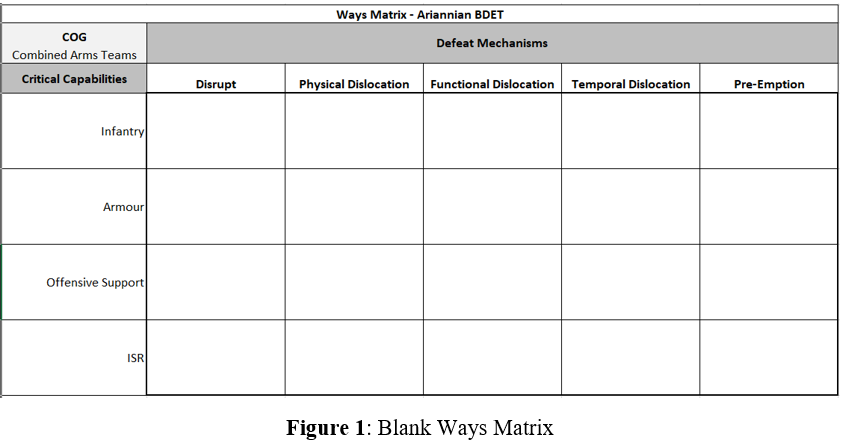
Then, using your IPB and MA, you can decide on ways you can use the defeat mechanisms to target the enemy. A rudimentary, and certainly not comprehensive, example of a Ways Matrix is at Figure 2 for understanding (noting you should strive for multiple methods – the example contains only one or two per box purely for space saving/presentation). The more you can create (here is the importance of creativity in planning), the more substantial and ‘cunning’ your plans can be.
 Once complete, you can then select DEs to develop varied and different courses of action. Figure 3 shows an example of the DEs selected for two COAs, which can then be sequenced appropriately and taken into COA Development. Understandably, some DEs will not be achievable in conjunction with others, and when selecting which DEs to execute sometimes you can combine them into a single DE. As an example, when selecting COA 1 (the blue circles), it could be determined disrupting the tanks and functionally dislocating the infantry, by destroying their vehicles, could be achieved in the same geographic space – therefore they could meld into a single DE.
Once complete, you can then select DEs to develop varied and different courses of action. Figure 3 shows an example of the DEs selected for two COAs, which can then be sequenced appropriately and taken into COA Development. Understandably, some DEs will not be achievable in conjunction with others, and when selecting which DEs to execute sometimes you can combine them into a single DE. As an example, when selecting COA 1 (the blue circles), it could be determined disrupting the tanks and functionally dislocating the infantry, by destroying their vehicles, could be achieved in the same geographic space – therefore they could meld into a single DE. 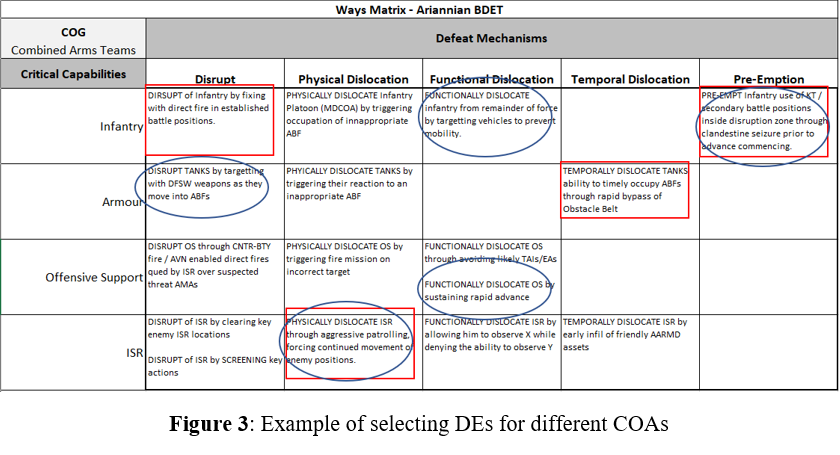
This step could be called the ‘art form’ of the tool, but it is not terribly difficult and, if the matrix is completed with good detail, will generate distinct COAs that all effectively undermine the enemy COG and are ‘manoeuvre-ist’ by nature.
Other examples of Ways Matrices are at the end of this article for further reference and assistance. Importantly, they also show another variety of Critical Capabilities for demonstration, proving that this can be applied to all enemy Centre of Gravity constructs.
Wrapping up, I felt so strongly about the benefit of this methodology – and after testing it throughout the entirety of COAC – I was soon convinced it was invaluable. I found it difficult to understand why it had taken so long in my career to get such a simple but effective demonstration of how to build DEs, as well as how they are useful. So convinced was I, that I proceeded to teach it to every subordinate officer I could find who had the patience (or perhaps just polite curiosity) to listen.
Ultimately, the Ways Matrix is not a doctrinal tool but an effective addition to our Military Appreciation Process. The usefulness of DEs will undoubtedly remain hotly contested, particularly for Combat Team, or even Battle Group, operations. Certainly as a Combat Team Commander I did not feel articulating DEs to my subordinate elements was necessary; however, they are an excellent method for planning how to defeat the enemy, using the Ways Matrix, which places greater emphasis on manoeuvre warfare principles.
Download your own Ways Matrix tool here Ways matrix
The below were developed in real-time planning events. The detail and quality vary based on the time available. As a result, some of the terminology may be incorrect, but the outcome is the same which is most important. Ultimately, despite some inconsistency, there are no more authentic, or ‘realistic’, example than the actual results. 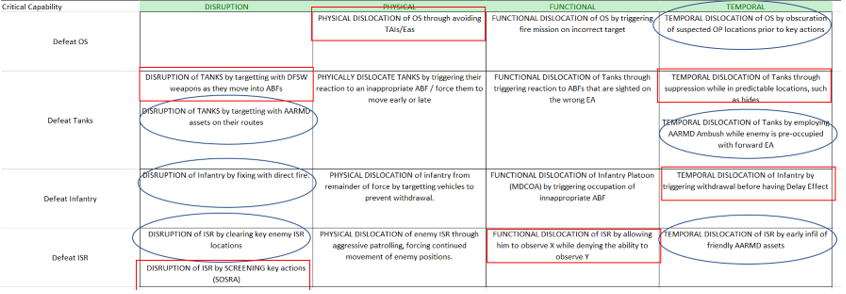

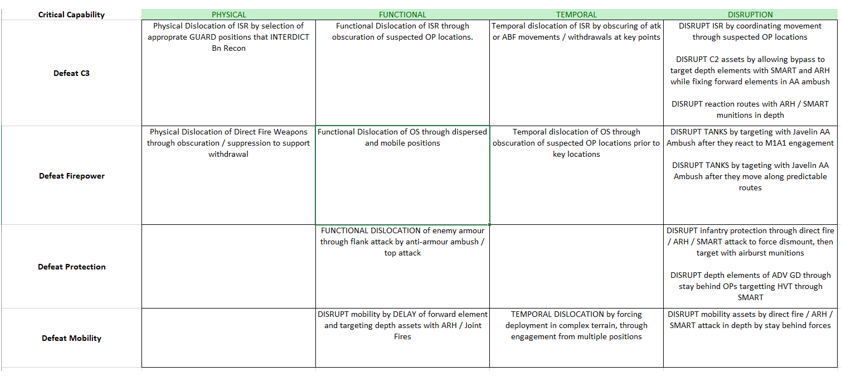
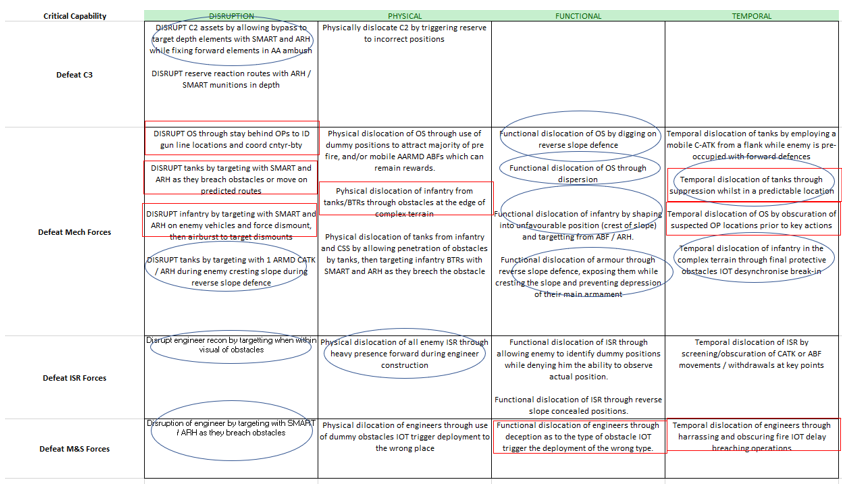 Special thanks to Majors Luke Wessel, Tom Green, Tim Mogridge, James Tarpley, Daniel Hebditch, Richard Bremner, and LTCOL Adam Reimers
Special thanks to Majors Luke Wessel, Tom Green, Tim Mogridge, James Tarpley, Daniel Hebditch, Richard Bremner, and LTCOL Adam Reimers









